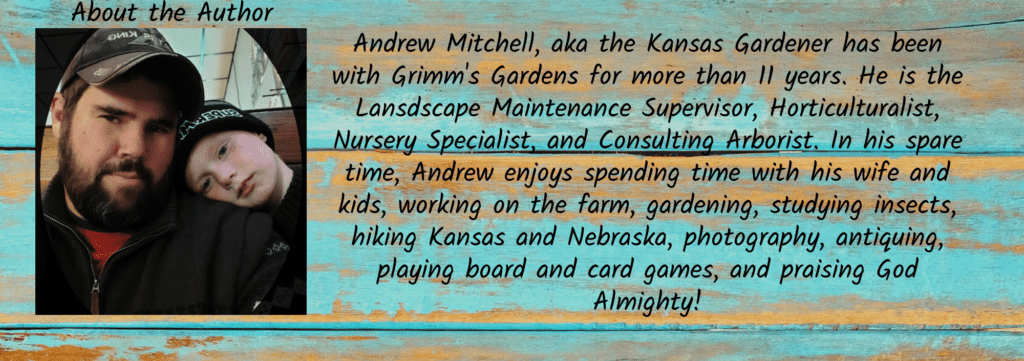We gardeners do not typically think as much about flowers for pollinators in late summer. Once August hits, its time to be a lazy gardener, resting in the hammock or taking the family on vacation. But the insects never get to take a break. They are always working. Therefore, we need to remember to plant perennials, shrubs, and trees (and annuals) for season-long nectar and pollen availability.
Pollinators do have their favorites, just like us. And they want to find them all blooming at the right time of year. Some perennials and shrubs are powerhouse bloomers, either naturally or bred to become so. Plant more of those and you will get a steady stream of pollinators visiting the flowers. But why do we need to keep them happy?
Because, pollinators also include beneficials such as wasps, parasitoids, predators, and food for other parts of the ecosystem (think birds). Without the diversity of different insect species, we would not have the diversity of birds, animals, and other parts of the ecosystem. And then we would have much bigger problems with pests.
8 Best Flowers for Pollinators in August and September
There are 7 species perennials and 1 tree that are powerhouses for pollinators during these last months of summer. I am blessed enough to have all of them in my own gardens, and I hope that you add some to your gardens as well.
Tall Sedum (Hylotelephium spectabile)
One of my favorite flowers for massing, tall sedum is tough, durable, and long lived. Old-timers call it live forever, a common name I only learned about 10 years ago. When it comes to producing flowers for pollinators, sedum is always available in late summer and into autumn. Now, with the addition of new cultivars and hybridization, we can choose between flowers of pink, white, red, and yellow. And leaves can be chartreuse, green, or variegated.
Tall sedum grows best in full sun to light shade, but it may flop if it gets too much shade. Pair tall sedum with Rudbeckia ‘American Gold Rush’, Siberian iris, butterfly milkweed, or let it stand alone in rows or masses.
- ‘Coraljade’ grows 18 inches tall by 28 inches wide. It has dark green leaves and coral pink flowers. Hardy to Zones 3-9.
- ‘Night Embers’ grows 26 inches tall and wide. It has burgundy leaves and dark red flowers. Hardy to Zones 3-9.
- ‘Autumn Fire’ is an improvement over the old standard ‘Autumn Joy’. It grows 24 inches tall by 36 inches wide. It has dark green leaves and reddish pink flowers. Hardy to Zones 3-9.
- ‘Autumn Charm’ grows 18 inches tall and wide, with green and white variegated foliage. The flowers are neon pink and it is hardy in Zones 3-9.
- ‘Lemonjade’ grows 18 inches tall by 24 inches wide with green leaves and yellow-green flowers. It is hardy in Zones 3-9.

New England Aster (Symphyotrichum novae-angliae)
This aster can be found growing native in the Central Great Plains, Upper Midwest, and Northeastern US regions. A tall species, sometimes reaching 7 feet, it grows in 3 foot clumps along ditches, ponds, streams, and other moist areas. Typical flower color is rich purple, but mutation in flowers is common and you can often find shades of pink, mauve, red, lavender, and white.
In my own garden, I have 2 shades of pink collected from wild areas that are mowed at just about flowering time, as well as purple. In late summer and into fall, they bloom profusely and are often covered in honeybees and other insects. Plant New England aster in full to part sun, in moist but well-drained soil.
- ‘Grape Crush’ grows 4 feet tall by 3 feet wide, with bright purple flowers. It is hardy in Zones 3-8.
- ‘Pink Crush’ grows 2 feet tall by 3 feet wide with bright pink flowers. It is hardy in Zones 3-8.
- ‘September Ruby’ has red flowers and grows 4 feet tall by 3 feet wide. Hardy in Zones 3-8.

Joe Pye Weed (Eutrochium purpureum)
According to legend, a native American medicine man was using tinctures of this plant to cure typhoid fever. His name was Joe Pye, therefore the plant he used was named in his honor.
Joe pye weed is native to the Central Great Plains and Midwest regions. It grows 4 to 6 feet tall and forms large clumps, 2 to 4 feet across. The flowers are pinkish-purple and slightly sweet smelling. Plant Joe Pye weed in the center of a flower bed, or pair it with ‘Northwind’ switchgrass, ‘Sparkling Sapphires’ baptisia, or mix it into a meadow garden.

Marsh Milkweed (Asclepias incarnata)
You cannot have a list for pollinator plants without at least one milkweed on it. Marsh or swamp milkweed starts blooming in July or August and really attracts a lot of insects in August. It is the tallest of our native milkweeds, and is found in the Central Great Plains, Northern Great Plains, and Midwest regions.
You will find marsh milkweed growing on the edges of ponds, lakes, streams, marshes, and ditches. Flower color can be either pink or white. One of my favorite cultivars of this perennial has white flowers. Plant marsh milkweed in a wet spot, though it is quite drought tolerant. Put it into bog gardens, next to ponds, in swales or ditches, or mix into a wet meadow. Pair it with great blue lobelia, cardinal flower, Obedient plant, Culver’s root, or switchgrass.
- ‘Cinderella’ has pink flowers and grows 5 feet tall by 3 feet wide. Hardy in Zones 3-9.
- ‘Ice Ballet’ has white flowers and grows 5 feet tall by 3 feet wide. Hardy in Zones 3-9.

Common Boneset (Eupatorium perfoliatum)
This is one of the toughest perennials I have ever grown. I dug one out of yard that was being redone, and put it into a basket. Then I set the basket in the garden and promptly forgot about. 2 years later I see it blooming, still in the basket, with roots growing through the bottom. Amazing!
Common boneset can be found growing across the Midwest, Southeast, and Eastern Great Plains. It grows 2 to 4 feet tall and wide, and prefers moist conditions, such as along streambanks, ditches, and swales. Plant it in full sun, in a rain garden, meadow, or wet area.
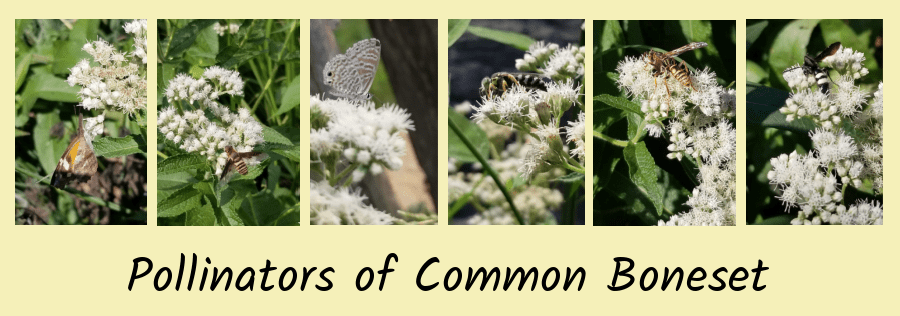
Aromatic Aster (Symphyotrichum oblongifolium)
If you are looking for a smaller, shrub-like perennial that blooms from August to November, then aromatic aster is the plant for you. It grows 2 to 3 feet tall and 3 to 4 feet wide. You can find it primarily in the Central Great Plains region. The flowers are smaller than New England Aster, but still 1 inch across.
Plant aromatic aster in full sun, where its roots will not get too wet. Put it into meadows, butterfly gardens, or mass it along a border. Pair it with butterfly milkweed, calamint, daylilies, and purple coneflower.
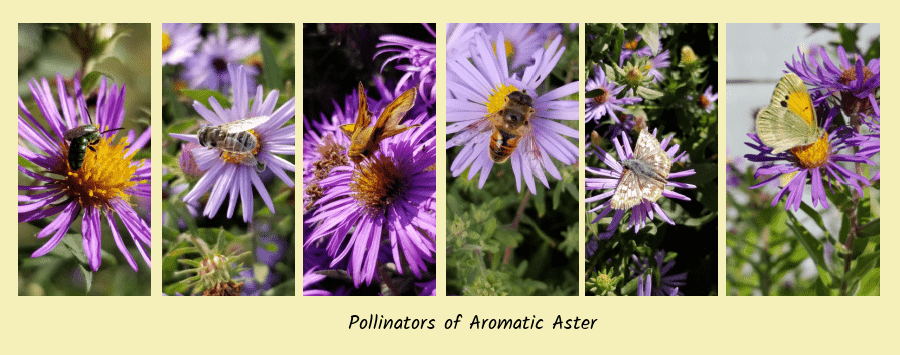
Calamint (Calamintha nepeta)
There is one plant in my garden that when ever I noticed it, it was blooming., That is calamint. It was always blooming, from July to November. And there was usually something on it, mostly sweat bees. The flowers are tiny and the plant actually looks weedy by itself. But in massing or paired with the right plant, it is awesome.
Plant calamint in full, hot sun, in a dry location. Pair it with catmint ‘Picture Purrfect’, butterfly milkweed, sedum ‘Autumn Fire’, or little bluestem. Plant it into cottage gardens, meadows, and butterfly gardens.
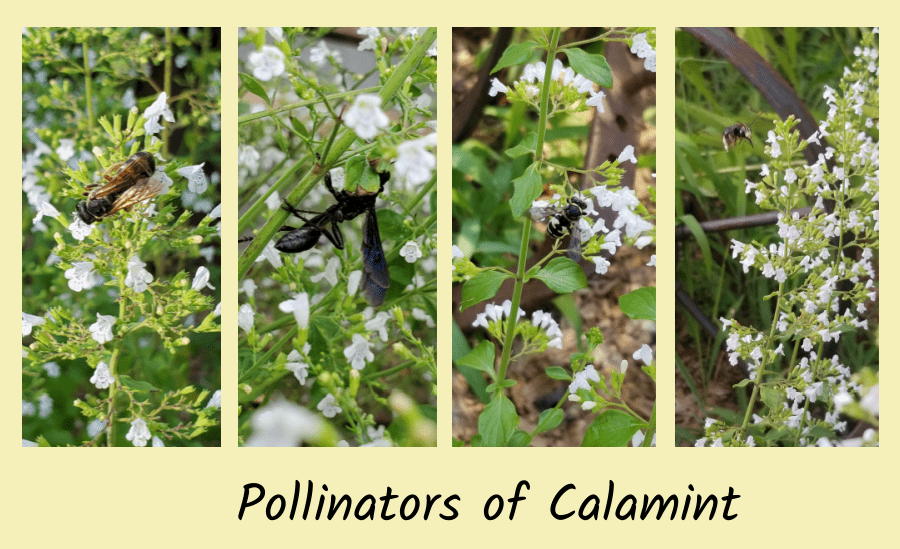
Seven Son Tree (Heptacodium miconioides)
The seven son tree is one of my favorite trees for the landscape. I love getting people to put them in their landscape. Seven son trees grow 15 to 25 feet tall and wide, making them the perfect centerpiece in the butterfly garden, or underneath power lines. Also, they bloom in August and September, making them one of the few fall blooming trees.
Plant seven son trees in full to part sun, in the center of a bed, by the house, or where it can be viewed best. It also has white and tan peeling bark, giving it 3 seasons of interest.
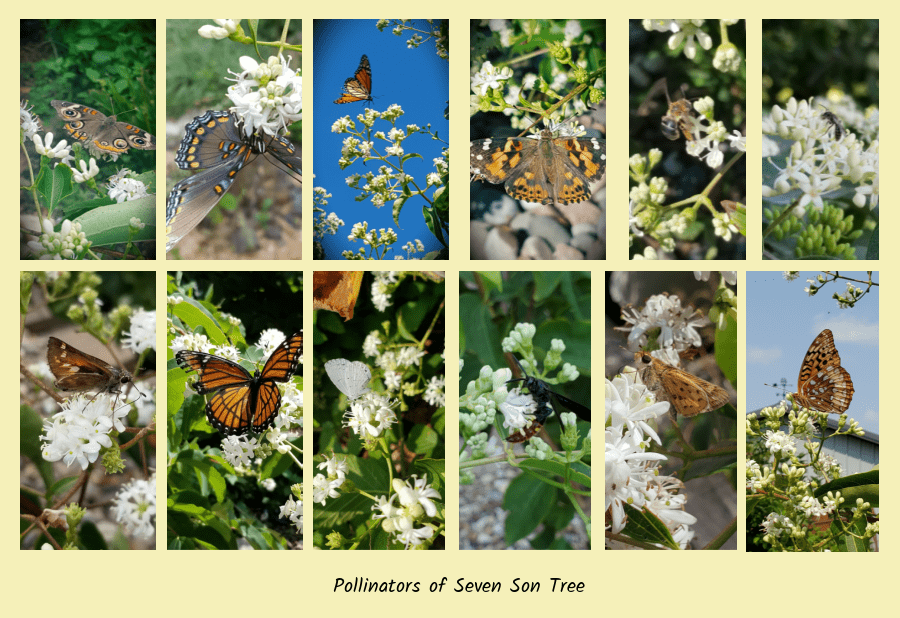
Other Plants for Pollinators in August and September
What about the other late summer and fall blooming perennials that attract pollinators? I have not even touched goldenrods yet. And there are many more asters. As a groups I wrote about asters in fall of 2021, and goldenrods will be the 2022 October Plant of the Month. But I will touch a little about them here.
Goldenrods (Solidago species)
There are 88 species of goldenrods in the United States, and 13 of those are found in the Central Great Plains. They are members of the Aster Family and are great for pollinators. Despite rumors, the pollen in non-allergenic, like its cousin, ragweed. There are many species which grow in a wide range of habitats and ecosystems.
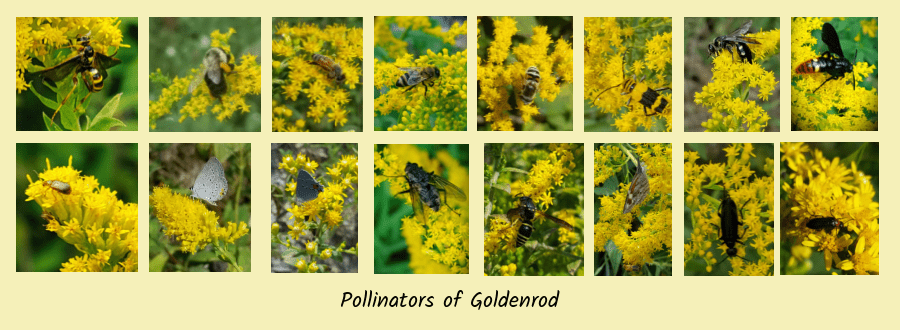
Rudbeckias
There are still a few other yellow flowers blooming in the garden which can be grown easily from seed. Rudbeckia ‘American Gold Rush’ pairs with a lot of other plants, and it has a long bloom time, from June to September. Rudbeckia triloba has small flowers on a large plant and is a continuous bloomer from July to September.
Wingstem (Verbesina alternifolia)
Almost unheard of outside of the native plant community, wingstem’s yellow flowers resemble other members of the Aster Family, such as sunflowers and silphiums. The plant has actual “wings” on its stems, one of its identifying factors.
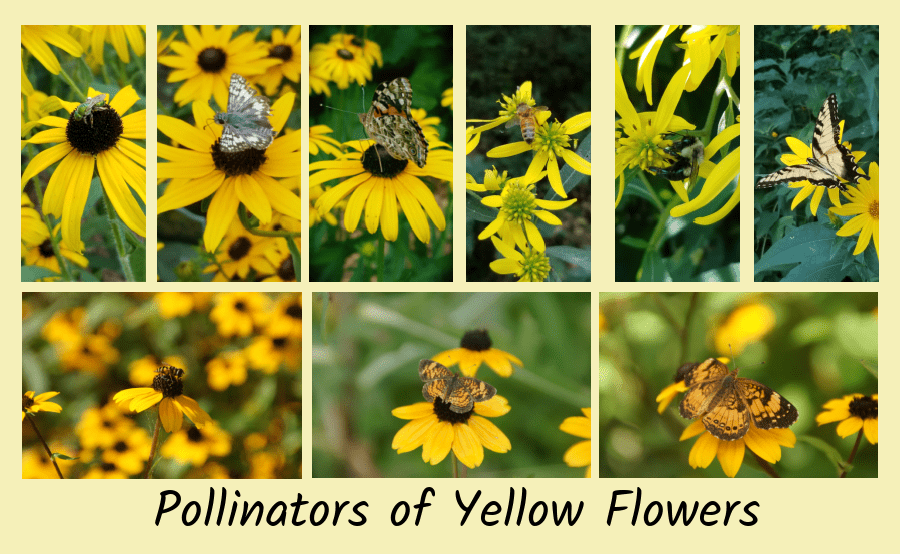
Other Pollinator Favorites for the Central Great Plains
- Obedient plant (Physostegia angustifolia)
- Blue sage (Salvia aurea)
- Cardinal flower (Lobelia cardinalis)
- Great Blue lobelia (Lobelia silphilitica)
- Garden phlox (Phlox paniculata)
- Hairy aster (Symphyotrichum pilosum)
- Tall boneset (Eupatorium altissimum)
- Downy Gentian (Gentiana puberulenta)

Conclusion
There is still a lot of variety in plants to consider for pollinators in late summer. Look for natives, especially goldenrods, asters, and other members of the Aster Family. Yellow, white, and pink flowers are in full bloom now. How will you spend your summer? Planting flowers for pollinators, or relaxing on the beach? I know where I will be. See you in the garden.
Happy planting!
